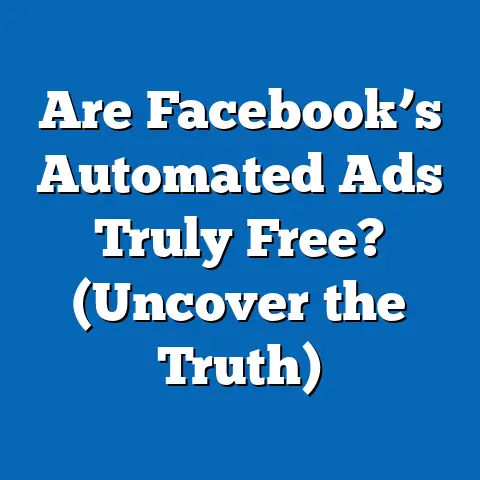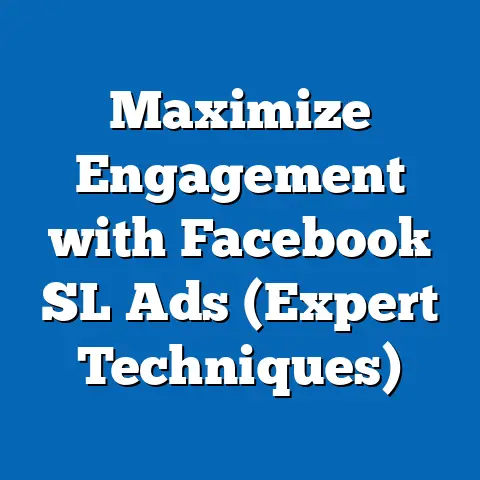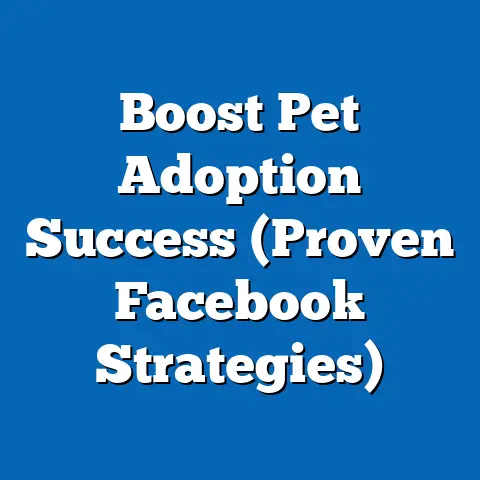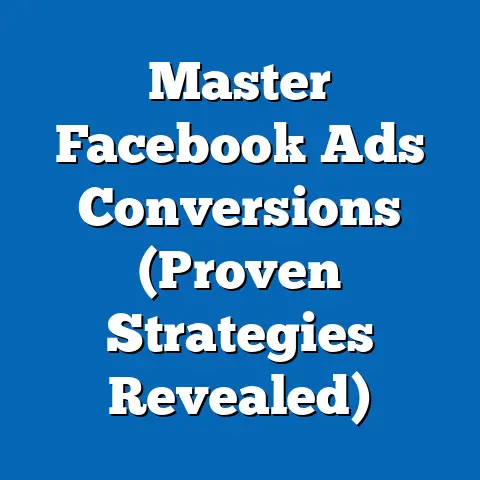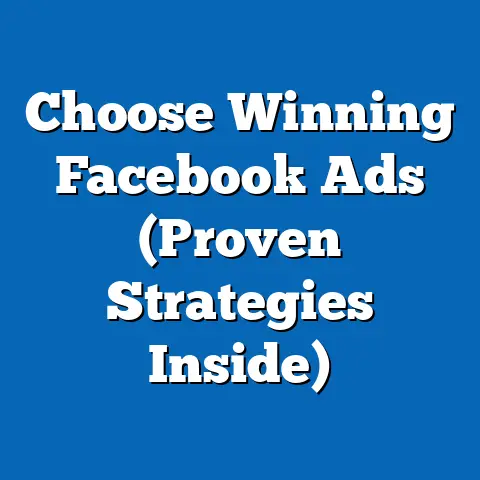Maximize Facebook & Instagram Ads (Proven Strategies)
In today’s world, “smart living” isn’t just about having the latest gadgets; it’s about leveraging technology to enhance every aspect of our lives. From smart homes to efficient transportation, technology is reshaping how we live, work, and connect. And at the heart of this transformation lies social media. Platforms like Facebook and Instagram have revolutionized how we communicate, shop, and engage with brands. As a digital marketing specialist with years of experience, I’ve witnessed firsthand how these platforms have become indispensable tools for businesses seeking to connect with their target audiences.
The power of Facebook and Instagram lies in their vast user base and sophisticated targeting capabilities. With billions of active users worldwide, these platforms offer unparalleled reach. But reach alone isn’t enough. To truly succeed in today’s competitive landscape, businesses need to adopt smart advertising strategies that resonate with their target audience and drive meaningful results. That’s where the connection between smart living and effective advertising comes into play. By understanding your audience, crafting compelling ad content, utilizing advanced targeting options, and optimizing ad performance, you can leverage Facebook and Instagram to achieve your business goals.
Section 1: Understanding Your Audience
Before you even think about creating an ad, you need to understand who you’re trying to reach. Knowing your target audience is the cornerstone of any successful advertising campaign, especially on platforms like Facebook and Instagram. Without a clear understanding of your audience’s demographics, interests, and behaviors, you’re essentially throwing money at the wall and hoping something sticks. I’ve seen so many campaigns fail simply because they didn’t take the time to understand their audience.
Fortunately, Facebook provides a wealth of tools and resources to help you gain valuable insights into your target audience. One of the most powerful tools is Facebook Audience Insights. This tool allows you to gather demographic data, interests, and behaviors of Facebook users. You can see their age, gender, location, education level, and even their relationship status. You can also see what pages they like, what topics they’re interested in, and what activities they engage in on Facebook.
For example, if you’re selling organic skincare products, you might use Audience Insights to see that your target audience is primarily women aged 25-45 who live in urban areas, are interested in health and wellness, and follow pages related to organic beauty and sustainable living. This information can then be used to create highly targeted ad campaigns that resonate with this specific audience segment.
Beyond demographics, it’s crucial to create buyer personas. A buyer persona is a semi-fictional representation of your ideal customer, based on research and data about your existing customers. This persona should include details about their motivations, goals, challenges, and pain points. By creating buyer personas, you can humanize your target audience and tailor your ad content to address their specific needs and desires.
I remember working with a local coffee shop that was struggling to attract new customers. After conducting thorough audience research, we created two distinct buyer personas: “The Busy Professional” and “The Relaxed Student.” We then crafted separate ad campaigns tailored to each persona. For “The Busy Professional,” we emphasized the coffee shop’s convenient location and quick service. For “The Relaxed Student,” we highlighted the cozy atmosphere and free Wi-Fi. As a result, the coffee shop saw a significant increase in foot traffic and sales.
Takeaway: Understanding your audience is paramount to success on Facebook and Instagram. Use tools like Facebook Audience Insights to gather data, create buyer personas, and tailor your ad content to resonate with your target audience.
Section 2: Crafting Compelling Ad Content
Once you understand your audience, the next step is to create compelling ad content that grabs their attention and motivates them to take action. This involves crafting captivating headlines, writing persuasive ad copy, and designing eye-catching visuals. I’ve learned that the best ads are those that tell a story and create an emotional connection with the audience.
The headline is the first thing people see, so it needs to be attention-grabbing and relevant to their interests. Use strong verbs, intriguing questions, and numbers to make your headlines stand out. For example, instead of saying “Learn More About Our Product,” try “Discover 5 Ways Our Product Can Transform Your Life.”
The ad copy should be clear, concise, and persuasive. Highlight the benefits of your product or service and address the pain points of your target audience. Use storytelling to create an emotional connection and make your ad more memorable. Don’t just tell people what your product does; tell them how it will improve their lives.
I once worked with a non-profit organization that was struggling to raise donations for a local animal shelter. Instead of simply asking for money, we created an ad campaign that told the stories of individual animals at the shelter. We featured photos and videos of these animals, along with heartwarming stories about their backgrounds and personalities. The campaign was incredibly successful, generating a significant increase in donations and adoptions.
Visuals are equally important. Use high-quality images and videos that are visually appealing and relevant to your message. Consider using bright colors, interesting compositions, and human faces to capture attention. Experiment with different ad formats, such as carousel ads, video ads, and stories ads, to see what works best for your audience.
Carousel ads are great for showcasing multiple products or features. Video ads are perfect for telling a story and creating an emotional connection. Stories ads are ideal for reaching a younger audience and creating a sense of immediacy.
Takeaway: Compelling ad content is essential for driving engagement and conversions. Craft captivating headlines, write persuasive ad copy, and design eye-catching visuals that resonate with your target audience. Experiment with different ad formats to see what works best for your message.
Section 3: Utilizing Advanced Targeting Options
Facebook and Instagram offer a wide range of advanced targeting options that allow you to reach your ideal customer with laser-like precision. Beyond basic demographics, you can target users based on their interests, behaviors, and connections. I’ve found that the key to successful targeting is to combine multiple targeting options to create highly specific audience segments.
Demographic targeting allows you to reach users based on their age, gender, location, education level, and relationship status. Geographic targeting lets you target users based on their location, down to the zip code level. Behavioral targeting allows you to reach users based on their online activities, such as their purchase history, browsing habits, and mobile device usage. Interest-based targeting lets you target users based on their interests, such as hobbies, sports, and entertainment.
But the real power of Facebook and Instagram targeting lies in custom audiences, lookalike audiences, and retargeting strategies.
Custom audiences allow you to upload your own customer data, such as email addresses and phone numbers, to create targeted audiences. This is a great way to reach your existing customers with special offers and promotions.
Lookalike audiences allow you to create audiences that are similar to your existing customers. Facebook analyzes your customer data and finds users who share similar demographics, interests, and behaviors. This is a powerful way to expand your reach and find new customers who are likely to be interested in your products or services.
Retargeting allows you to show ads to people who have previously interacted with your website or app. This is a highly effective way to re-engage potential customers who have shown interest in your brand. For example, you can show ads to people who have visited your website but haven’t made a purchase, or to people who have added items to their cart but haven’t completed the checkout process.
I worked with an e-commerce business that was struggling to convert website visitors into paying customers. We implemented a retargeting strategy that showed ads to people who had visited the website but hadn’t made a purchase. The ads featured the products that the visitors had viewed, along with a special discount code. As a result, the e-commerce business saw a significant increase in conversions and sales.
Takeaway: Facebook and Instagram offer a wide range of advanced targeting options that allow you to reach your ideal customer with laser-like precision. Utilize custom audiences, lookalike audiences, and retargeting strategies to maximize your reach and drive conversions.
Section 4: Optimizing Ad Performance
Creating a great ad is only half the battle. To truly maximize your ROI, you need to continuously optimize your ad performance. This involves monitoring your key performance indicators (KPIs), conducting A/B tests, and making data-driven decisions. I’ve learned that even the best ads can be improved with ongoing optimization.
A/B testing is the process of comparing two versions of an ad to see which one performs better. You can test different headlines, ad copy, visuals, and targeting options to see what resonates best with your audience. For example, you can test two different headlines to see which one generates more clicks, or you can test two different visuals to see which one drives more conversions.
Key performance indicators (KPIs) are metrics that you use to track the success of your ad campaigns. Some of the most important KPIs include:
- Click-through rate (CTR): The percentage of people who see your ad and click on it.
- Conversion rate: The percentage of people who click on your ad and complete a desired action, such as making a purchase or filling out a form.
- Cost per acquisition (CPA): The cost of acquiring a new customer through your ad campaign.
- Return on ad spend (ROAS): The amount of revenue generated for every dollar spent on advertising.
Use Facebook Ads Manager to analyze your ad performance and make data-driven decisions. Ads Manager provides a wealth of data and insights that you can use to optimize your campaigns. You can see which ads are performing well, which ads are underperforming, and which audiences are most receptive to your message.
Based on your performance data, adjust your budgets, tweak your ad copy, and refine your audiences. Don’t be afraid to experiment and try new things. The key is to continuously test and optimize your campaigns to improve your ROI.
I worked with a subscription box company that was struggling to generate a positive ROAS. After analyzing their ad performance, we discovered that their cost per acquisition was too high. We then conducted A/B tests to optimize their ad copy and targeting options. As a result, we were able to significantly reduce their CPA and improve their ROAS.
Takeaway: Optimizing ad performance is essential for maximizing your ROI. Monitor your KPIs, conduct A/B tests, and make data-driven decisions to continuously improve your campaigns.
Section 5: Staying Ahead of Trends
The world of social media advertising is constantly evolving. New trends and features emerge all the time, and it’s important to stay updated to remain competitive. This involves following industry blogs, attending conferences, and experimenting with new strategies. I make it a point to dedicate time each week to stay abreast of the latest developments.
Some of the emerging trends in Facebook and Instagram advertising include:
- Influencer marketing: Partnering with influencers to promote your brand to their followers.
- Shoppable posts: Allowing users to purchase products directly from your posts.
- The rise of short-form video content: Creating short, engaging videos that capture attention and drive engagement.
You also need to be aware of algorithm changes and evolving user behaviors. Facebook and Instagram are constantly tweaking their algorithms, and these changes can have a significant impact on your ad performance. Stay informed about these changes and adapt your strategies accordingly.
For example, Facebook has been prioritizing content from friends and family over content from businesses. This means that it’s becoming increasingly important to create organic content that resonates with your audience and encourages them to engage with your brand.
I’ve seen many businesses struggle to adapt to these changes. The key is to be flexible and willing to experiment. Don’t be afraid to try new things and see what works best for your audience.
Expert predictions on the future of social media advertising include increased personalization, greater emphasis on video content, and the rise of augmented reality (AR) and virtual reality (VR) advertising.
Takeaway: Staying ahead of trends is essential for remaining competitive in the world of social media advertising. Follow industry blogs, attend conferences, and experiment with new strategies. Be aware of algorithm changes and evolving user behaviors, and adapt your strategies accordingly.
Conclusion
In conclusion, maximizing your Facebook and Instagram ad campaigns requires a combination of strategy, creativity, and data-driven decision-making. By understanding your audience, crafting compelling ad content, utilizing advanced targeting options, optimizing ad performance, and staying ahead of trends, you can achieve your business goals and drive meaningful results.
Remember, smart living is about leveraging technology to enhance our quality of life. And in today’s digital age, that means embracing the power of social media advertising to connect with your target audience and grow your business.
The potential of digital advertising to transform businesses in today’s fast-paced, tech-driven world is immense. By implementing these proven strategies, you can unlock that potential and achieve unprecedented success.
Now, I’d love to hear from you! What are your experiences with Facebook and Instagram ads? What strategies have worked well for you? Share your thoughts and experiences in the comments below. And if you’re looking for further insights and tips on maximizing your advertising efforts, don’t hesitate to reach out. I’m always happy to help!

